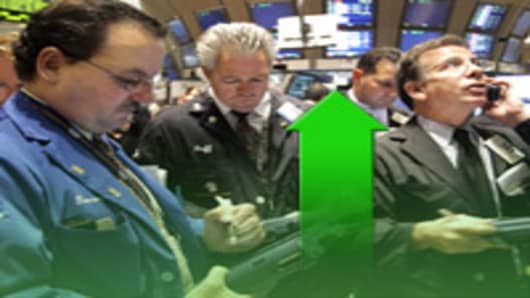Even with a more than 30 percent gain since October, stocks could continue to drift higher into the quarter end.
Strategists have been expecting a pull back since last month, when major indices broke above the highs of last year, but several say there are few catalysts right now to sway things much in either direction.
Bank of America Merrill Lynch technical analyst Mary Ann Bartels, in fact, sees the market’s own success as a reason for it to go higher over the next two weeks as investors, who have missed the year’s gains so far, step in to buy.
“We have nine more trading days until the end of the quarter. Without any big macro event, it would be very hard to take the market down,” she said.
“At least based on our anecdotal evidence, most clients across the board are underinvested for this move,” Bartels said. “I think we’re going to have heavy window dressing.”
That could all change come April, when the ‘sell in May’ effect could start to take hold, amid such catalysts as earnings season, more important economic data such as nonfarm payrolls, and a Fed meeting. Analysts are also watching rising oil prices, which could sting stocks if they move too high, and some say rising interest ratescould become a concern if they keep going higher.
Will Bond Yields Hurt Stocks?
“Stocks and bonds had a pretty ugly divorce a while back. If you look at the 10-year as a benchmark, 10-year yields have gone nowhere,” said Jordan Kotick, global head of technical strategy at Barclays.
The 10-year yield has been rising dramatically since the Fed upgraded its view of the economy last week. The 10-year yield was at 2.37 percent in late afternoon trading Monday.
The Treasury market selloff continued Monday after comments from New York Fed President William Dudley, who said there’s no decision yet on further quantitative easing, and it will depend on the economy.
On Tuesday, traders in all markets will continue to watch yields. CRT Capital senior Treasury strategist Ian Lyngen said the next level to watch is 2.417 percent, the 10-year’s intraday high yield from October.
There is little in the way of economic news to stir the market, with just housing starts on the calendar at 8:30 a.m. ET. But Lyngen said that may not matter to the market, which is likely to see more selling.
“There was nothing going on today, and we sold off five basis points. Technical momentum is bearish enough. Momentum is negative enough,” he said. “A test of that level (2.417) might prove a good buying opportunity.”
Jeffrey Palma, UBS Global head of equity strategy, said the bond market move is not a concern. ”I don’t think it has to be considered a negative. We’re at a stage in the cycle, where rising rates reflect better growth,” he said.
But Palma also does not see the bond market selloff as a signal that a new wave of fresh capital is about to roll into stocks.
“I’m a little skeptical that we’re going to see the big wall of money coming into stocks…we’ve had equities rising since October. Now to call this the big asset allocation trade is probably exaggerating the point. Could there be a quarter-end window dressing event going on? There certainly could be,” he said.
The S&P 500 was up 4 Monday at 1409, giving it a 12 percent gain year-to-date and a 31 percent gain since Oct. 4. The Dow rose 6 to 13,239 Monday, and it is now up 8.4 percent year-to-date, while the Nasdaq , up 23 at 3078 Monday, is up 18.2 percent since Jan. 1.
Bartels said the Nasdaq is leading the market, and that’s healthy. “That just came out of an 11-year trading range, and it’s in a new secular bull market. Our target is 4000.”
Apple, up 45 percent since the start of the year, has been a major engine for the Nasdaq. The stock rose 2.7 percent to close Monday at 603, its first close above $600, following news that it would pay a dividend for the first time and buy back stock.
Bartels also expects the financials to continue to gain, as the steepening yield curve is bullish for banks. Financials were higher Monday, but Bank of America slid amid rumors, later denied, that it would issue more stock.
“As long as earnings come out consistently without major blowups, I think the market can grind higher. I think this market may be more ‘sell in May’ and go away,” Bartels said.
Kotick has been looking for a pull back and expects seasonality to play a role. “We are still bullish but we are cautious,” Kotick said. “…And you always have to be aware as we go into the ‘sell in May’ season, the upside is in play.”
“1400 is an interim target. We’re (targeting) mid to upper 1400s so to our mind we’re not done yet. We’re just getting into a seasonal slow spot,” Kotick said.
Oppenheimer technical analyst Carter Worth is more convinced of a sell off than some. He said, in a note, that S&P at 1400 is a selling point, and the longer the market goes without correcting, the worse the break will be.
What Else to Watch
Fed Chairman Ben Bernanke Tuesday morning lectures students at George Washington University School of Business. Meanwhile, the Senate Banking Committee at 10 a.m. considers nominees Jerome Powell and Jeremy Stein to be members of the Fed board of governors.
Earnings news is expected from Tiffany and Jefferies before the bell, and Oracle after the market close.
Voters in Illinois head to the polls in the GOP primary.
Treasury Secretary Timothy Geithner appears before the House Financial Services Committee at 10 a.m. to discuss the state of the international financial system.
Rep. Paul Ryan, R-Wis. puts forth a new budget plan Tuesday.
Follow Patti Domm on Twitter: @pattidomm
Questions? Comments? Email us at marketinsider@cnbc.com



